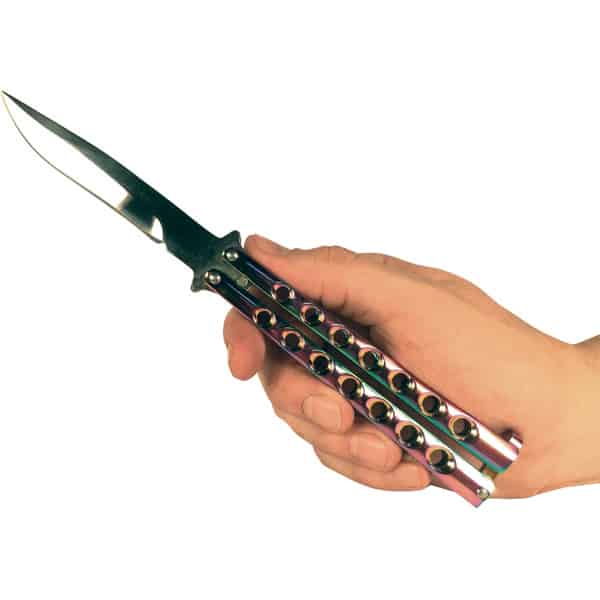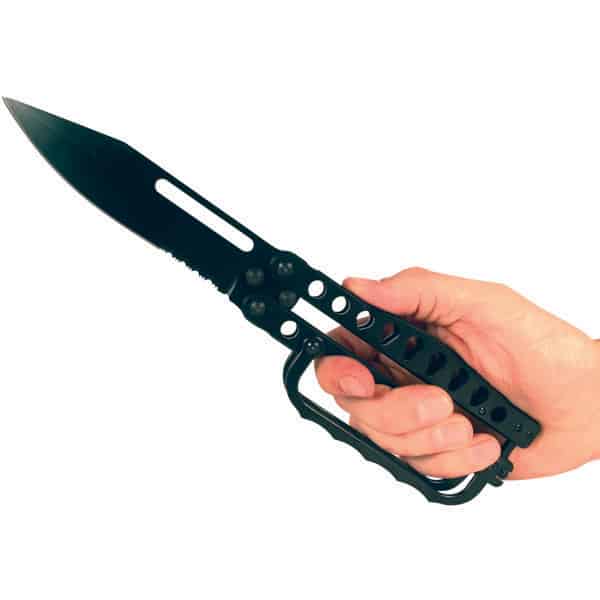
Isn’t it fascinating how butterfly knives have cut through time, transitioning from a symbol of old-school cool to a beacon of modern mastery?
You’re about to enter a world where the blend of tradition and innovation creates a dynamic playground for enthusiasts.
These iconic blades have evolved from simple tools to intricate art pieces, offering much to explore beneath the surface.
Discover how these knives carve a niche in the modern era, leaving you wondering what secrets are hidden within their folds.
While the butterfly knife, also known as the balisong, emerged in the early 18th century in the Philippines, it’s fascinating how it evolved from a simple agricultural tool to a global martial arts and craftsmanship icon.

You’d be intrigued to learn that the journey of the butterfly knife isn’t just about its unique opening mechanism or its role in Filipino martial arts; it’s also a story of innovation in materials and design. Initially, these knives were made with basic materials like wood and brass, serving the practical needs of farmers and villagers.
Then if you dive deeper, you’ll discover that the evolution of balisongs embraced various blade styles, catering to utilitarian and aesthetic preferences. The craftsmanship became more sophisticated, integrating advanced materials such as carbon fiber into the handles. This reduced the weight and enhanced the durability and appeal of these knives.
Building on the rich history of innovation, the design and evolution of butterfly knives have seen remarkable advancements in form and functionality. These tools have transformed from traditional designs into modern masterpieces, pushing the boundaries of what’s possible with a butterfly knife. Today’s versions are more than just cutting tools; they blend art and precision engineering.
The evolution of butterfly knives can be broken down into three key areas:
As you delve into the world of butterfly knives, you’ll appreciate how the blend of tradition and innovation creates a captivating experience for collectors and enthusiasts alike.
Diving into modern flipping techniques, you’ll discover that these advanced moves, including aerials, rollovers, and twirls, require a blend of momentum, balance, and precision.
When handling butterfly knives, flipping transforms from mere manipulation to a display of skill and dexterity, techniques like the helix, zen rollover, and fanning aren’t just tricks; they’re a language of their own, showcasing the flipper’s ability to control and command the blade through a series of intricate movements.

Modern flipping techniques vary widely, from the practical everyday carry (EDC) maneuvers to the more artistic, freestyle performances that captivate audiences. Whether you’re flipping for a utility or the sheer thrill of it, the key lies in continuous practice.
Developing muscle memory and fine-tuning your movements are crucial to mastering these techniques. Each flip, twirl, or roll is a testament to your dedication, as you harmonize momentum, balance, and precision into a seamless flow. As you progress, you’ll enhance your skills with butterfly knives and join a community of flippers who share a passion for modern flipping techniques.
Joining a balisong community can enrich your collecting journey with insights and camaraderie from fellow enthusiasts. In butterfly knife collecting, you’ll find that personal preferences play a huge role in shaping your collection. Whether it’s the craftsmanship, materials, or the sheer beauty of the designs, each aspect adds a unique layer to your hobby.

Building your collection isn’t just about acquiring pieces; it’s about understanding the diversity and history behind them. Exploring different designs and materials brings depth to your collection, making it more than just a set of knives—it reflects the balisong community’s evolution. Staying informed about the latest trends and releases is crucial. It keeps you connected with the community and helps you decide which pieces to add next.
As you grow your collection, you’ll find it’s not just about the knives themselves but about being part of a passionate community that shares your love for these intricate tools.
Are you wondering why a butterfly knife is illegal in certain locations? It’s often due to their concealable nature and quick deployment, which classify them as switchblades in many places, leading to strict laws and potential criminal charges for possession. You will need to check with your local law regarding any restrictions.
You’re probably wondering which butterfly knife trick tops the difficulty chart. It’s the Y2K. This trick demands precise timing and control, setting it apart as the toughest challenge for flippers aiming for mastery.
Butterfly knives are cool because of their unique flipping action, historical significance, and eye-catching designs. They’re customizable with various handle materials and blade finishes, making them highly sought after by collectors and enthusiasts alike.
Pepper Spray Wholesale provides non-lethal self defense products and hidden cameras for you, your loved ones and your home. If you have any questions about the products, do not hesitate to Contact Us. Stay Safe!
Pepper Spray Wholesale
1867 Caravan Trail
Ste 105
Jacksonville, FL 32216
Call us toll free: (800) 859-5566